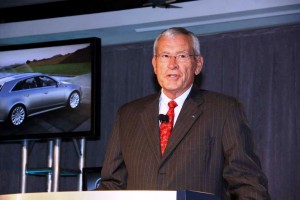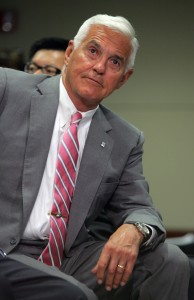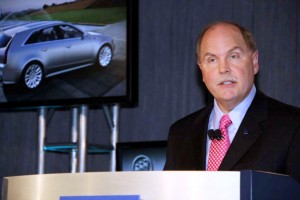General Motors Company, or the new GM, is abandoning the old way of doing business that drove it into bankruptcy, according to its CEO. He also will streamline its organization, focus on “best in class” products and attract enough customers to stop its sales slide.
The U.S. taxpayer-owned company is expected to go public by the middle of next year. And GM wants to pay off its U.S. loans that are currently keeping it afloat well before the required 2015 date.
These are all extremely ambitious goals, to put it politely, coming from a management team comprised almost entirely of old-line GM executives who set the policy and made the decisions that resulted in the largest corporate bankruptcy in U.S. history.
“One thing we have learned from the last 100 days is that GM can move quickly and decisively,” said Fritz Henderson, CEO. “Today, we take the intensity, decisiveness and speed of the past several months and transfer it from the triage of the bankruptcy process to the creation and operation of a new General Motors.”
The problem confronting GM — new or old — is the continuing decline in production, sales and share in the toughest vehicle market since WW2.
Little new ground in the all critical product or cost cutting areas was covered by Henderson in his first press conference as the operational head of GM Company, which was created today by an asset sale approved by a bankruptcy court in New York on July 5th. In fact, the cliche’s of a product and customer focused organization, repeated over and over, seemed more suitable for an internal pep rally than for a news event after a near death experience for a company whose future is still by no means assured.
Even the claim that GM can move quickly was cast in doubt by the lack of detail in just how GM is going to trim its bloated corporate ranks. Henderson’s new management organization was being prepared in anticipation of a July 31st closing date, and the restructuring could not keep pace with the swiftness of the bankruptcy proceeding.

"I'd like to see us grow organically and gain marketshare. We have the talent. Ask me again in a year," Whitacre told TDB.
In his first public appearance, Edward E. Whitacre, Jr., the new chairman of the board, said he agreed to take the job because “I know many Americans want this company to succeed.” Whitacre claimed that the fundamentals are in place to revive GM. He said, “You’re going to see a lot of action around General Motors.”
Most of the actions are already announced, planned or in place. Four core brands, Chevrolet, Cadillac, Buick and GMC, will remain in the U.S. and a newly pared dealership network of about 3,600 will exist by the end of next year. This still remains the largest dealership organization in the country.
In the U.S., the GM Company will be leaner. As previously announced, by the end of 2010, the company will operate 34 assembly, powertrain, and stamping plants, down from 47 in 2008, and capacity utilization is expected to reach 100% during 2011. Overall U.S. employment will decline from about 91,000 at the end of 2008 to about 64,000 at the end of 2009.
Without question, GM Company begins with a stronger balance sheet, including U.S. debt of approximately $11 billion. This excludes preferred stock of $9 billion, which is also a significant liability. In total, obligations, reduced by more than $40 billion, are mostly in unsecured debt and the Voluntary Employee Beneficiary Association (VEBA) trust fund that provides medical benefits to UAW retirees.
The stronger balance sheet and lower break-even point — in theory — allows the GM to operate profitably at much lower volume levels. Current break even is thought to require 10 million annual sales in the U.S., a rate that has not been obtained thus far this year, and that is not sufficient to fund new products or pay the 9.5% interest on GM debt.
Ultimately the management team must prove it can make enough money to reduce its debt, pay back the loans and invest in competitive new products.
As part of the required cost cutting, the GM North American and regional management organizations are being dissolved, but final details for both will not be announced until the end of July, as noted the anticipated closing date, instead of today. Therefore the futures of the head of GMNA, Troy Clarke, and all other regional vice presidents and staffs under them are unknown. Some will retire, some will remain and some will leave the company, according to Henderson.

"The number one challenge is to get consumers to recognize that we have great products," Lutz told TDB this morning.
One organizational change of significance was made. Bob Lutz has changed his mind about his previously announced retirement. Lutz joins the new GM as vice chairman responsible for “all creative elements of products and customer relationships.”
The 77 year-old Lutz and Tom Stephens, vice chairman, product development, will work with Ed Welburn, vice president of design, to guide all “creative aspects” of design. They are all old GM hands. GM’s brands, marketing, advertising, and communications will report to Lutz, who is holding his first creative review next Monday. He will report to Henderson, and be part of a newly formed executive committee.
“The number one challenge is to get consumers to recognize that we have great products,” Lutz told TDB. He admitted that if it was clear how to do this he “would have done it yesterday.” While GM has been reorganizing itself for years, it’s sales and share continue to decline. Year-to-date GM sales in the U.S. are off more than 40%, and are down 20% in Europe.
General Motors Company common stock will initially be owned by the U.S. Department of the Treasury, at 60.8%, the UAW Retiree Medical Benefits Trust, 17.5%; the Canadian federal and Ontario governments, 11.7%; and the Motors Liquidation Company (old GM), 10%. For a closer look at the new legal structures prompted by the reorganization, click here.


